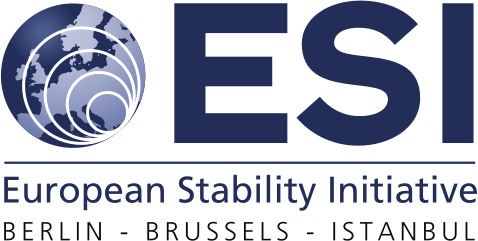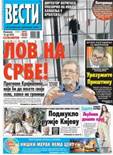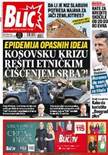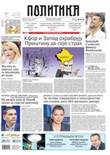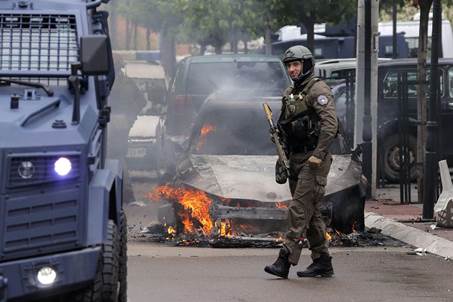Belfast, Kosovo and the end of peace
- Words matter
- “An eagerness for trouble”
- Bitter memories
- The grey rhino
- Licence plates and the failure of the dialogue
- The Ohrid paradox
- Sanctions, isolation and a dangerous temptation
- Sovereignty – the heart of the matter
- How this dialogue came to an end
“Once again, I warned that the Serbian people in Kosovo and Metohija are exposed to the most severe torture and persecution in the last 15 years.”
Dear friends,
Today, Serbia and Kosovo stand at the brink of a catastrophe. It is urgent for European powers to act in time and in a way that can pre-empt it.
As James Waller, professor of genocide studies, has written, the coming of violent conflict is rarely an unpredictable black swan. It is, as strategist Michele Wucker put it, more often a “grey rhino”.
“The grey rhino is a massive two-ton thing with its horn pointed at you, stomping the ground and getting ready to charge – and most importantly, giving you the chance to act.”

Words matter
“The pogroms, persecution and ethnic cleansing that the regime in Pristina is implementing against the Serb population are well organized … I am aware that some will want to say later that I am taking Serbia back to the 1990s. But if we do not protect the Serbs in Kosovo they will blame us for not doing enough.” (Serbian president Aleksandar Vucic, 6 July 2023)
On 6 July this year, Serbian president Aleksandar Vucic declared publicly that NATO and the UN had fourteen days to disarm Kosovo’s police forces and to protect Kosovo Serbs from ongoing Albanian “pogroms and ethnic cleansing.” Otherwise “someone else” would need to do this. These fourteen days have since passed.
Of course, warnings that Serbia might need to send troops into Kosovo to protect Serbs are not new. Already in August 2018, when the president of Kosovo was Hashim Thaci, Serbian president Aleksandar Vucic described Kosovo as a powder-keg:
“Everyone will wait for an opportunity to strike the other in order to achieve an advantage on the ground. And every day we will worry if they will attack us in the North, where they will strike us, with whose support …”
In February 2019, foreign minister Dacic explained on television: “Let us be clear about one thing, people: if there is an attack on Serbs in North Kosovo, we will have to defend them militarily, not with prayers. We must be aware of that.” On 13 March 2019, Dacic repeated this warning: “Serbia will not allow an attack on the Serbs in the North. Of course, Serbia will not allow attacks anywhere in Kosovo, but they [the Kosovo government] are obsessed with the North.” On 15 March 2019, Dacic explained: “In case KFOR does not guarantee security, which it is obliged to do according to UN resolution 1244, in case there is an armed attack on Serbs, Serbia will defend them.”
There is one recent change. Previous statements argued that if Serbs are attacked in Kosovo, Serbia will defend them. Recent statements argue that Serbs are now attacked and need to be defended. This was the message Aleksandar Vucic delivered on 6 July 2023, transmitted by all major media channels in Serbia.
The present moment was, he began, “the most difficult” since he joined the Serbian government as minister of defence in 2012, eleven years ago. Vucic again accused the Kosovo government of carrying out “pogroms”:
“A year ago, the regime in Pristina decided to arrest, murder or remove from the territory of Kosovo all well-known Serbs, who would not accept unilateral actions from the authorities in Pristina.”
He accused the Kosovo police of trying to “intimidate Serbs in the North … to leave Serbs hungry and without medicine, to bring fear into every Serb household.” Vucic warned that this persecution of Serbs is “increasing the risk of their total disappearance from Kosovo.” He noted that any Serb not opposing the Kosovo government was a traitor: Pristina was buying “some miserable Serbs that would like to flatter the occupier and do things against their own people.” Describing the Kosovo government as “occupier” made clear: this is an enemy, not a neighbour.
Recent developments, Vucic concluded, left Serbia few options: “the situation has spiralled out of control. It is clear that Serbia and Serbs have been put against the wall.” He proposed one last meeting with Jens Stoltenberg, the NATO Secretary General (it has since taken place), and an emergency session of the UN Security Council on Kosovo. He warned:
“Depending on the response … we will learn who has the obligation to protect lives and freedom of Serbs. Is it KFOR in line with the UN Security Council Resolution 1244, or is it someone else?”
Vucic even put a deadline: “In the next 14 days we will inform all our international partners about what decisions we have taken.”
The next day, the pro-government tabloid Informer, which claims to be the most read daily in Serbia, summed up his message:
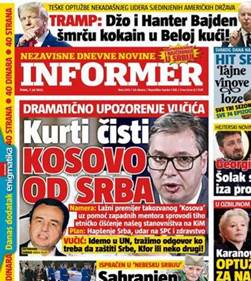
Informer – 7 July 2023
“A dramatic warning from Vucic: Kurti [Albin Kurti, the prime minister of Kosovo] is cleansing Kosovo of Serbs. The intention: the fake prime minister of so-called ‘Kosovo’ is implementing silent cleansing of our population from Kosovo and Metohija with the help of Western mentors. The plan: Arrest Serbs, attack the Serb Orthodox Church and health sector. Vucic: We are going to the UN to ask for an answer of who must protect Serbs, KFOR or someone else!”
It should not be difficult for international organisations to rebut these false, misleading and dangerous claims. None of the many international observers with staff on the ground in Kosovo – from KFOR to EULEX, the EU Rule of Law Mission, from UNMIK to the OSCE – have seen “pogroms”, “ethnic cleansing of Serbs” or Albanian “terror” in recent years. The most recent report of the UN Secretary-General about Kosovo to the UN Security Council from April 2023 offers a 26 pages long detailed description of developments over a six month period. It reports on 12 incidents affecting Serbian Orthodox religious sites and cemeteries, from damages to tombstones to the placement of an Albanian flag on the door of a Serbian Orthodox church. It writes about an instance when stones were thrown at a vehicle with Serbian licence plates; about the breaking of the windows of four Kosovo Serb-owned shops; about the beating of two Kosovo Serbs by members of a Kosovo police special operations unit; and about a few other cases of inter-ethnic physical attacks, with perpetrators from both communities. It refers to “a number of separate incidents related to the theft and burning of Kosovo, Albanian and Serbian flags” and to “several incidents of verbal and physical abuse by members of the Kosovo Police special operations unit reported in northern Kosovo.” The most serious cases of violence against Serbs, reported from September 2022 to March 2023, were the following:
“Two Kosovo Serbs (one 11-year-old boy and one 21-year-old man) were shot by a Kosovo Albanian man, an off-duty member of a Kosovo security institution; the suspect was later arrested by the Kosovo police.”
“On 6 November, a Molotov cocktail was thrown at the house of a Kosovo Serb in Kissnica/Kishnicee village, Gracanica/Gracanice municipality which led to the arrest of two Kosovo Albanian juveniles by Kosovo police.”
Every incident is one too many. Any increase in inter-ethnic violence is concerning. And every instance deserves to be investigated in the interest of all citizens of Kosovo. What is clear, however, is that there is neither “state terror” nor “ethnic cleansing.” And yet, in recent weeks, such talk of Serbs under attack has reached a frenzy in media close to the Serbian government, with constant, daily articles accusing the Kosovo government (and other allegedly hostile neighbours such as Croatia).
“Hunting Serbs! Displaced Krajina Serbs [Serbs in Croatia] who wanted to visit their villages are arrested on the border … This is one example of “silent exodus” that is applied also in the so-called state of Kosovo, says Savo Strbac (Vesti, 10 July 2023)
Kurti: I want “Operation Storm” in Kosovo. I offered Serbs from the North the Croatian model, which is a success-story, said Albin Kurti. With that he openly stated that the goal is to expel the Serb population (Informer, 12 July 2023)
Epidemic of dangerous ideas: Kosovo crisis should be solved by ethnic cleansing of Serbs?! (Blic, 13 July 2023)
KFOR and the West are encouraging Pristina to sow fear (Politika, 15 July 2023)
This is more than the background noise of routine politics. It is advisable to take recent announcements by Serbian officials seriously. There is a recent West European experience that is particularly relevant here now, both as a warning and as a pointer towards a good way forward: Northern Ireland, from 1969 until today.
“An eagerness for trouble”

IRA funeral in Northern Ireland
There had been ominous signs. The killing of a Catholic civilian, standing outside his house, by a Protestant fanatic in Belfast in May 1966. Civil rights marchers clashing with police, leaving many dozens injured in Derry/Londonderry in October 1968. The prime minister of Northern Ireland warning that the province risked becoming “a place continually torn apart by riots and demonstrations” in February 1969. However, in summer 1969 there had been peace in Northern Ireland for decades. Everybody could see the dark clouds on the horizon, but nobody predicted the tragic turn that was soon to lead to more than 3,700 deaths in the most serious violent conflict in Western Europe in decades.
Malachi O’Doherty was 18 years old in summer 1969. Living in Belfast, he had “grown up so far without knowing serious sectarian violence … I did not come to my teens with a settled understanding that I had a sectarian war to fight.” Then, in early August 1969, three-days of battles between Catholic protestors and the Northern Irish police erupted in the city of Derry/Londonderry. Days of intercommunal clashes in Belfast followed. By the end of August, over 170 houses had been burnt down and nearly 500 more had been damaged.
With this, the dragon of fear and hate was awake. The Irish Republican Army or IRA, a paramilitary force created to fight the British in Ireland in the early 20th century, had been dormant for decades. It was mocked in 1969 by Catholics it claimed to defend as standing for “I Ran Away.” One historian noted that its arsenal in Belfast that summer was “a machine gun, a pistol and some ammunition.” But all that changed quickly in summer 1969.
People “stunned by what had happened … gathered into groups and acquired weapons for the next recurrence … [this] turned into an expectation of more trouble, and, for some, an eagerness for trouble” (O’Doherty). The violence of the moment revived memories of past violence. Young men on both sides of the conflict joined those who evoked heroic fighters of the past: “It was just a case of going in and putting your hand on a flag and saying some oath … It was a great feeling.”

The turn to chaos (O’Doherty)
The Civil Rights movement in Northern Ireland had focused on social housing, electoral reform and non-discrimination. Its tool was peaceful demonstrations. The paramilitaries focused on sovereignty. Their tool was violence. Might the border between Ireland and Northern Ireland be erased? Might Northern Ireland join Ireland? Republicans saw themselves fighting a war of decolonization. Loyalists saw themselves fighting terrorists, who tried to break an unbreakable bond to Great Britain. Given the history of violence in Ireland between Catholics and Protestants, between Irish Republicans and those in favour of the Union with the United Kingdom, there was no shortage of justifications to seek revenge. Every murder, every attack, poured more oil into the fire.
Defined as a matter of sovereignty, it also began to seem impossible to find a compromise: either Derry (the name used by most Catholics) was a city in Ireland, or Londonderry (the name used by most Protestants) remained a city in the United Kingdom. How could it be both? Either there was a border between two states on the island of Ireland, or there was none.
The Troubles, as this violent conflict became known, was no war fought by regular armies. And the deployment, from August 1969 onwards, of tens of thousands of UK troops to Northern Ireland failed disastrously to stop the lethal trend:
In 1970, there were 25 deaths.
In 1971, there were 174 deaths.
In 1972, there were 467 deaths.
The violent conflict lasted for three decades. It led to 42,000 injuries and over 3,700 deaths (more than 1,800 of them civilians) in a population of 1.8 million. 39 percent of the residents of Northern Ireland experienced a conflict-related traumatic event. In Northern Ireland, life after August 1969 became “so much more awful than most of us anticipated” (O’Doherty). And it remained so until the peace of 1998.
Bitter memories
O’Doherty had not experienced violent conflict growing up in Northern Ireland until he was 18 years old. The same is true for Kosovars – Albanians and Serbs - who are 18 years today. But even the young generation grew up with stories of a violent recent past.
Their parents remember the brutal repression in Kosovo during the Milosevic era in the 1990s; the eruption of fighting between Albanian paramilitaries (the KLA) and Serbian authorities in 1998; the massacres of civilians; the expulsion of hundreds of thousands of Kosovars by Serb forces and paramilitaries; NATO’s military intervention in 1999; and the dangerous period immediately after the 1999 war, which saw further assassinations, targeting mainly Serbs.
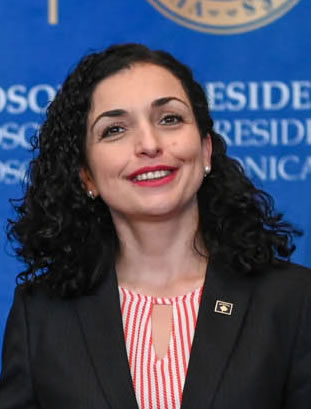


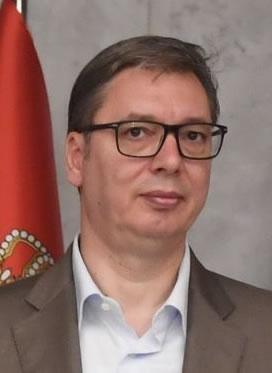
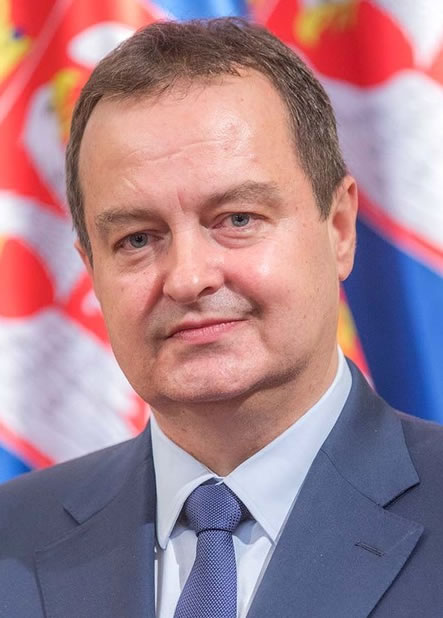
Vjosa Osmani – Albin Kurti – Donika Gervalla-Schwarz – Aleksandar Vucic – Ivica Dacic
Memories of this history persist among key politicians in Pristina and Belgrade today, who experienced this period very differently:
The president of Kosovo, Vjosa Osmani. She was born in Mitrovica in 1982. She lived there until, still a teenager, she was driven by Serb forces to flee with her family from their home.
The prime minister of Kosovo, Albin Kurti. He was born in 1975 in Pristina. He was a student leader during protests in 1997/98. He was arrested under Milosevic, sentenced to 15 years and imprisoned in Serbia. He was released only in December 2001.
The foreign minister of Kosovo, Donika Gervalla-Schwarz. She was born in Skopje in 1971. She fled with her family from Kosovo to Germany in 1980, as her father, a political activist, fled persecution in communist Yugoslavia. In 1982, he, his brother and another activist were murdered by Yugoslav agents near their new home in Germany.
The president of Serbia, Aleksandar Vucic. He was born in 1970 in Belgrade. He was the secretary general of the Serbian Radical Party in the early 1990s and Milosevic’s minister of information at the time of the 1999 Kosovo war.
The foreign minister of Serbia, Ivica Dacic. He was born in 1966 in Prizren in Kosovo. He was spokesperson of the party of former Serbian leader Slobodan Milosevic from 1992 to 2000.
The most recent discussion on Kosovo at the UN Security Council in New York on 27 April 2023 shows what these memories mean for inter-governmental negotiations. The UN debate was supposed to be about “normalizing relations between Serbia and Kosovo.” In fact, it highlighted how far from normalization relations remain.
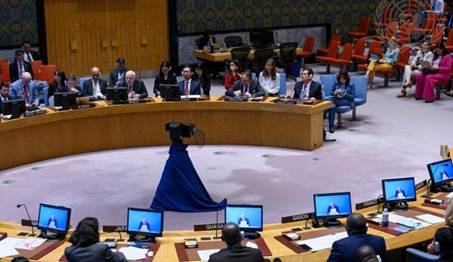
UN Security Council in April 2023
The debate began with today’s Lebanese head of the United Nations Interim Administration Mission in Kosovo warning that Pristina and Belgrade stood “worryingly close to the edge of physical confrontation.” Serbian foreign minister Ivica Dacic then spoke about pressure against Serbs in Kosovo. Kosovo, he explained, is as important for Serbia as Jerusalem is for Jews. Dacic remarked that the dialogue between Belgrade and Pristina was marked by “extremism and racism against Serbs.” He explained that for centuries each square metre of Kosovo land has been covered with Serb blood. His message: Kosovo was part of Serbia and would remain so. Noting that there was continuing disagreement over this, he asked if there should be a war. Dacic also referred to the (assassinated) father of Kosovo foreign minister Gervalla as a separatist, who had wanted Kosovo independence, even through war. Dacic then turned to the Kosovo foreign minister herself: “So your hands are bloody.”
Kosovo foreign minister Donika Gervalla-Schwarz also remarked that without the presence of US and NATO troops there might already be another war. She warned that Kosovo would never again “be a defenceless victim of aggression and genocide.” She recalled that there were over 1,600 missing persons in Kosovo, who were “presumably killed, abducted and buried by Serbian military and militias.” She pointed out that Serbian President Vucic had been “the propaganda minister for war criminal Slobodan Milosevic, while the right-hand man of the so-called Butcher of the Balkans is the man who just spoke before me, responsible for mass murder, rape as a weapon of war and war crimes.” She referred to Dacic as “small Slobodan Milosevic” and called him an angry man, because he lost Kosovo forever. Dacic’s reference to her father made clear to her that, for him, “the assassination of a journalist wanting peace is acceptable … The terrorists were the ones who burned down villages, slaughtered thousands of people, including babies and the elderly, brutally raped women and girls, denied everything and even celebrated genocide.”
The grey rhino
There are many reasons to worry about the eruption of conflict in and around Kosovo this summer, other than bad relations between key leaders. Understanding these reasons is important if one wants to prevent an eruption. The first, and most obvious, is the collapse of interethnic cooperation in North Kosovo.
An official EU statement on “10 years of Belgrade-Pristina Dialogue” in March 2021 still celebrated the achievements of this dialogue:
“10 years ago, on 8 and 9 March 2011, Edita Tahiri, Borko Stefanovic and Robert Cooper [Kosovo and Serbian negotiators and EU mediator] sat down for the very first time to leave the past behind and discuss how to find ways forward for the future cooperation between Kosovo and Serbia … The goal was clear: to promote cooperation, achieve progress on their respective European path, and improve the lives of the people … 10 years on, much has been achieved … people and goods move freely between Kosovo and Serbia, the judiciary and police structures in northern Kosovo have been integrated.”
Today, this has not been true for almost nine months. On 5 November 2022, 3,500 Kosovo Serbs collectively resigned from their official positions and jobs in Kosovo, following a meeting called by the main Kosovo Serb party, Srpska Lista. Serbian foreign minister Ivica Dacic described this mass resignation as “historic.” Those who stepped down included the only Serb minister in the Kosovo government – Goran Rakic, the leader of Srpska Lista – and two Serb deputy ministers, all 10 Serb members of the Kosovo Assembly, 578 police officers, 25 judges, 10 prosecutors and 141 judicial support staff. Serbs left all positions in the police and judiciary in the North of Kosovo, though not in the South. The four mayors in the North also resigned, as did Serb municipal council members.
On 14 November, EU High Representative Josep Borrell warned that the absence of Kosovo Serbs had left police stations and courts in North Kosovo dangerously understaffed: “In this vacuum, the worst can happen.” At the time, less than 50 Kosovo Albanian police officers were manning all police stations in the region. The 578 Serb police officers who had resigned were, once again, directly paid by Belgrade.
The Kosovo government has since tried to recruit new Serb police officers. More than 100 applied, new ones have been trained, some already graduated from their training, but there are many times that number of vacancies. The Kosovo government has sent more police and staff from elsewhere in Kosovo to the North. It also has shored up the position of its special police forces there, building new permanent barracks to house them.
Since November 2022, the crisis only deepened. Under Kosovo law, the resignation of mayors and municipal councils demanded new elections in the four municipalities in the North of Kosovo. The Kosovo government, following a request of the Quint (US, UK, Germany, France, Italy), postponed these elections from December 2022 to April 2023. Still, Kosovo Serbs decided to boycott them. As a result, a small minority of Albanian voters in the North elected four Albanian mayors, over the protest of the majority Serb population.
This is no stable situation. Unlike the government of Northern Ireland, which withdrew from parts of Catholic Derry in summer 1969, the Kosovo government is determined not to withdraw from the North. But as the UK army found out in Northern Ireland, once it had returned to take control of all of Derry in 1972, there were limits to what police and military could achieve faced with a hostile population. Withdrawing is no solution. Imposing authority by force alone is no solution either.
In the meantime, signs of trouble are multiplying:
– the most serious clashes between protestors and KFOR in a very long time erupted on 29 May 2023, when armed Serb protestors attacked KFOR soldiers, Kosovo police, and journalists. Some 30 KFOR soldiers were injured; one Hungarian soldier had to have his leg amputated.
– possibly the most serious breach of the June 1999 Military Technical Agreement between KFOR and Serbia in two decades took place when, on 14 June 2023, Serbian special police forces abducted three Kosovo border police officers and kept them as prisoner in Serbia for twelve days. While Serbian authorities claimed that these arrests happened on Serbian territory, Kosovo police presented evidence that the abduction took place well inside Kosovo at the police officers’ duty point. KFOR units examined the scene of the abduction already in the afternoon of 14 June. KFOR saw the results of a detailed internal investigation undertaken by the Kosovo police. What is remarkable: KFOR has remained silent on what happened. This sends a dangerous signal. If Serbian forces had entered Kosovo it would have been a clear violation of the 1999 Military Technical Agreement between KFOR and Serbia which stated that: “under no circumstances shall any Forces or the Federal Republic of Yugoslavia and the Republic of Serbia enter into, reenter or remain within the territory of Kosovo …[they shall] refrain from committing any hostile or provocative acts of any type against any person in Kosovo.”
– on 23 June, the Kosovo minister of interior reported that Kosovo police had stopped a Serb car moving weapons in North Kosovo. The Serbian government said that these weapons “were planted.”
Licence plates and the failure of the dialogue
At the same time as tensions increase in the North, the framework designed in 2011 to deal with crises, the EU-led dialogue, is suffering from its own deep crisis of credibility. To understand this, let us examine the story of Kosovo car licence plates, which triggered the mass resignations of Kosovo Serbs in November 2022.
Until the 1999 war, all car licence plates in Kosovo were issued by Serbia. These plates indicated the area in Kosovo where people came from: such as (Kosovska) Mitrovica or KM.

From 1999 to 2008, only UNMIK had the authority to issue car licence plates in Kosovo. It issued plates without identifying any area. They simply stated KS (Kosovo).

Following Kosovo’s declaration of independence in 2008, and after the transfer of authority from UNMIK to the institutions of the Republic of Kosovo, new licence plates were issued. These did not indicate areas either, but included RKS (Republic of Kosovo).

Then, at one of the first EU-led dialogue meetings in July 2011, Kosovo and Serbia agreed on the future of car licence plates in Kosovo. This agreement was clear:
“All car owners residing in Kosovo will use either RKS or KS vehicle license plates. These will be issued by the relevant authorities in Kosovo … Each party will do its best to ensure the implementation of above.”
The Kosovo government agreed to issue KS (old UNMIK) licence plates for a transition period of 5 more years, until 2016. Serbian (KM) plates would go out of use.
In most of Kosovo, this happened. Kosovo Serbs living in the South switched to RKS plates. Even the Serb major of North Mitrovica used an official car with a plate issued by the Kosovo government in 2022. Meanwhile the Pristina government continued to issue also KS plates. For some this was convenient, as Serbia allows cars with KS plates to enter Serbia without complications (RKS plates need to be replaced at the border with temporary plates). There was one problem, though: Serbia also continued to issue Kosovo Serbs in the North with illegal Serbian (KM) plates. Thousands of cars with Serbian plates remained in use, a breach of the 2011 agreement.
In 2016, the Dialogue returned to this question. The Kosovo government agreed to issue UNMIK (KS) plates for another five more years until 2021. Agreement was also reached on a deadline to phase out Serbian (KM) plates:
“The registration of all vehicles with licence plates issued by Kosovo authorities (KS/RKS) will commence on 15 January 2017 and will last for 12 months …”
Again, however, this phasing out of Serbian (KM) plates did not happen. Serbia continued to issue them and Kosovo Serbs continued to use them.
In early September 2021, at a technical dialogue meeting in Brussels, Kosovo announced that it would not extend the interim agreement on UNMIK (KS) plates, running out in mid-September, for a third time. It also announced that it planned to enforce the prohibition of Serbian (KM) plates for Kosovo residents. In the morning of 20 September 2021, the Kosovo police began to enforce its licence-plate policy also in North Kosovo, one decade after it had been agreed upon in the dialogue.
The result was violence and clashes. Immediately, protestors in the north blocked traffic at the border gates with Serbia. Special units of the Kosovo police were deployed to these border gates in armoured vehicles, utilizing also tear gas to disperse protesters. Quickly, the number of protesters and Kosovo special police units grew. Serbia’s president described the attempt to enforce the Kosovo licence plate law as “criminal.” Serbia responded with heavy threats. On 23 September, Serbia put its troops on high alert along the Kosovo border. As the UN wrote later: “the Serbian army deployed a platoon-strength reaction force in the vicinity, north of the Administrative Boundary Line, and conducted several military overflights in the same area.”
Some diplomats appeared taken aback that the Kurti government was trying to implement the 2011 dialogue agreement on licence plates. One UNMIK report concluded:
“The fact that that effort was not discussed through established channels – in the first place, the EU-facilitated dialogue on freedom of movement – resulted in an avoidable yet potentially dangerous escalation of tensions lasting for 10 days.”
Some also began to blame Kosovo authorities for taking the initiative. Then a compromise was found on 30 September 2021 in Brussels: to take the issue back to the EU-facilitated dialogue. EU mediator Miroslav Lajcak announced on Twitter the establishment of a working group, chaired by the EU, with a deadline of six months, to prepare “a permanent solution” until April 2022.
Six months passed. Seven meetings were held. The working group went nowhere. Kosovo Serb leaders explained openly why this was the case. The Serb mayor of North Mitrovica told the New York Times that preserving Serbia-issued KM licence plates was essential to “defend our way of life and identity.” This was not about car plates, but about the principle of sovereignty: “no Serb will ever accept Kosovo as an independent country.” Serb leaders understood the use of Kosovo licence plates as a de facto acceptance that the North is part of Kosovo, something which the deputy leader of the dominant Serb party in Kosovo defined in late 2022 as an attack on Kosovo Serb identity: “We are not Kosovo Serbs but Serbs … I am not ready to change my identity.”
And so, within the dialogue, discussions on licence plates lurched from crisis to crisis. The Kosovo government continued to insist on implementing the law. It announced that from the end of October 2022, cars with Serbian license plates would no longer be able to circulate or cross borders without being admonished. On 26 October, Serbian president Vucic stated that Serbian license plates would remain. On 28 October, the US State Department issued a press statement:
“The United States, alongside our international partners, urges the government of Kosovo to extend the implementation period for the new license plate regime. Kosovo has the right to implement the license plate regime under the Brussels Agreement, but an extension of the timeline is in the interest of making progress on the EU-facilitated dialogue to normalize Kosovo-Serbia relations.”
The logic: in order to make further progress in the EU-dialogue, Kosovo was to set aside what had been agreed earlier in this dialogue. If it did not, it would be cast as irresponsible:
“The United States is disappointed and concerned that the government of Kosovo has rejected requests to do so from its international partners … It is important that both parties reduce inflammatory rhetoric …”
On 28 October prime minister Kurti announced that from 1 November drivers with Serbian plates would only be reprimanded. From 23 November, they would be fined. From January 2023, they would be forced to attach probationary plates to their cars. Kurti explained that citizens in the North would be able to benefit from tax benefits after re-registering their cars. What he did not do was to give up on the issue.
And then, things unravelled. In response to his government’s decisions, Nenad Djuric, the Serbian regional director of the Kosovo Police in the Serb-majority North, declared on 3 November that the Kosovo police under his command would not implement the government’s decision. It would not reprimand drivers, whatever Kosovo law said. Djuric was suspended by the Kosovo ministry of interior. The following day, he declared that he would not return to the Kosovo police. On 5 November, after a big meeting in North Kosovo, all Kosovo Serbs in political and administrative positions in the four Serb-majority municipalities in the North and in the central institutions in Pristina, resigned.
Licence plate diplomacy continued from crisis meeting to crisis meeting. On 11 November 2022, EU mediators met once again with Kurti and Vucic in Paris. An EU press statement demanded: “Kosovo Serbs should immediately return to Kosovo institutions and resume their duties, and Kosovo should align its actions on licence plates to past dialogue agreements.”
Kosovo Serbs did not return. On 21 November, one day before fines for cars with Serbia-issued KM licence plates were supposed to enter into force, Kurti and Vucic met yet again in Brussels. Following an 8-hour meeting, Josep Borell explained that he expected Serbia to stop issuing new KM licence plates and for “Kosovo to immediately suspend further stages related to the re-registration of vehicles in North Kosovo.” But there was no agreement. Kurti then accepted to postpone the imposition of fines for 48 hours. On 23 November, another meeting took place between the Kosovo and Serbia chief negotiators. At the end there was an announcement by Borrell:
“We have a deal!
Very pleased to announce that Chief Negotiators of #Kosovo & #Serbia under EU-facilitation have agreed on measures to avoid further escalation and to fully concentrate on the proposal on normalisation of their relations. Serbia will stop issuing licence plates with Kosovo Cities’ denominations & Kosovo will cease further actions related to re-registration of vehicles.”
Following this, Serbian chief negotiator Petar Petkovic celebrated that “with this agreement, starting today at eight o’clock, there will be no fines of 150 euros planned by Albin Kurti.” Serbian (KM) licence plates would remain: “We are talking about plates that are legally issued by the Republic of Serbia … They will continue to be in use as they were until now.” Petkovic stressed that all owners of cars with Serbian-issued plates could sleep in peace. “We saved our KM plates.” In Belgrade, President Vucic was also content: “KM plates still remain … around 7,000 of them [Serbs using these plates] on the territory of Kosovo and Metohija can continue to drive their cars without interference.”
On 24 November 2022, Josep Borrell told Euronews that:
“The Parties understand that all past agreements must be implemented … I would like to point out, that we also agreed that in case of obstruction by either party, the EU facilitator may terminate the process.”
But Serbia did not implement the licence plate agreement. Not after 2011, not after 2016, not in 2023. 13 years have passed since the 2011 commitment on licence plates. Kosovo authorities are unable to enforce it. The issue triggered the collapse of integration in the North. And even after implementation was postponed once more in late November 2022, Kosovo Serbs continued to boycott Kosovar institutions. For years, the insistence of the Kosovo government to enforce its law on licence plates was instead presented by Belgrade as a provocation. But where does this leave the EU-dialogue as a tool to get results?
The Ohrid paradox
The approach to focus on technical issues to build trust is failing in the face of determined Serbian opposition to any assertion of Kosovo sovereignty in the North. But is there another way to move the dialogue forward? Can it focus on the big picture, and settle technical details later?
This is what Germany and France set out to try in autumn 2022. They had a simple idea: Kosovo and Serbia should treat each other in the same way in which West-Germany and East-Germany treated each other after ratifying a Basic Treaty (Grundlagenvertrag) in 1972. After ratifying the Basic Treaty, East Germany joined the United Nations. Instead of de-jure there would be de-facto recognition.
The 1972 Basic Treaty text was slightly adapted and, voila, a new master key was found to unlock the Kosovo Serbia conflict. Or so it seemed. The 1972 Treaty had ten articles, the last one on ratification. The version of the Franco-German proposal for a Kosovo-Serbia Agreement leaked in November 2022 had nine articles (and none on ratification). Otherwise the two texts were almost identical:
Article 1
The Federal Republic of Germany and the German Democratic Republic shall develop normal good neighbourly relations with each other on the basis of equal rights.
Kosovo and Serbia shall develop normal, good neighbourly relations with each other based on equal rights.
Article 3
In accordance with the United Nations Charter, the Federal Republic of Germany and the German Democratic Republic shall settle their disputes exclusively by peaceful means and refrain from the threat or use of force. They reaffirm the inviolability now and in the future of the border existing between them and undertake fully to respect their territorial integrity.
In conformity with the SAA [Stabilisation and Association Agreements] signed by both parties, Kosovo and Serbia shall settle any disputes between then exclusively by peaceful means and refrain from the threat or use of force. They reaffirm the inviolability now and in the future of the frontier/boundary existing between them and undertake fully to respect each other’s territorial integrity.
Article 4
The Federal Republic of Germany and the German Democratic Republic proceed on the assumption that neither of the two States can represent the other internationally or act in its name.
Kosovo and Serbia proceed on the assumption that neither of the two parties can represent the other in the international sphere nor act on its behalf.
Article 8
The Federal Republic of Germany and the German Democratic Republic will exchange permanent missions. They will be established at the respective seat of government. Practical questions relating to the establishment of the missions will be dealt with separately.
Kosovo and Serbia shall exchange Permanent Missions. They shall be established at the respective Government’s seat. Practical questions relating to the establishment of the Missions shall be dealt with separately.
This leaked nine-article draft was in turn very similar to the eleven-article text put before Kosovo and Serbia in Brussels on 27 February 2023. The only additions were a few sentences inspired by earlier agreements:
“Both Parties shall mutually recognise their respective documents and national symbols, including passports, diplomas, licence plates, and customs stamps.”
“Serbia will not object to Kosovo’s membership in any international organisation.”
“Both Parties commit to establish specific arrangements and guarantees, in accordance with relevant Council of Europe instruments and by drawing on existing European experiences, to ensure an appropriate level of self-management for the Serbian community in Kosovo and ability for service provision in specific areas, including the possibility for financial support by Serbia and a direct communication channel for the Serbian community to the Government of Kosovo. The Parties shall formalise the status of the Serbian Orthodox Church in Kosovo and afford strong level of protection to the Serbian religious and cultural heritage sites, in line with existing European models.”
The idea behind the Basic Agreement approach seemed plausible. It had worked before (in 1972), so it might work again (in 2023). However, it quickly became clear that there was a fatal and fundamental difference: while both governments in Bonn and East Berlin wanted this Basic Agreement, in 2023 one party saw no interest at all in such a deal: Serbia.
While Aleksandar Vucic, a hypnotic master of diplomatic communication, managed to express himself vaguely enough with diplomats to allow them to engage in wishful thinking that he was somehow on board, the position of his government was made crystal clear immediately to the audience that mattered most: the Serbian public. Already on 27 October 2022, the Serbian National Security Council decided that the Franco-German proposal was unacceptable. This was communicated to the public by foreign minister Ivica Dacic on 6 November, shortly after the mass withdrawal of Serbs from Kosovo institutions. The Franco-German plan, Dacic explained, implied “the position that the independence of Kosovo is already a done deal … It does not give us a chance to negotiate, because the basis from which it starts, that Kosovo is an independent state, is unacceptable to us.”
Throughout January 2023, diplomats worked hard to get Kosovo and Serbia to accept the Basic Agreement. Miroslav Lajcak (the EU’s special envoy for the dialogue), Gabriel Escobar (the US envoy for the Western Balkans) and Emmanuel Bonne, Jens Plotner and Franceso Talo (the foreign policy advisers of the leaders of France, Germany and Italy) travelled to Pristina and Belgrade. After meeting on 21 January, Aleksandar Vucic stated that he had reservations on “one important issue … but I cannot talk about it, because the proposal is not public.” He then added that this day had been “one of the most difficult days for our country … We have many hardships and problems that we will face in the future, that’s why we need unity.” Serbian prime minister Ana Brnabic claimed that Serbia faced the most difficult time since World War Two, adding that pressures were getting stronger.
On 6 February, Albin Kurti met with EU mediator Miroslav Lajcak and endorsed the proposed Basic Agreement: “We accept the European Union’s proposal for the normalisation of relations between Kosovo and Serbia and consider it a good basis for further discussions, as well as a solid platform to move forward.” So did, on 9 February, the European Council, welcoming “the recent European proposal to put the relationship between both parties on a new and sustainable basis as a historic chance that should be seized by both parties.”
On 27 February, Kurti and Vucic met with Miroslav Lajcak and Josep Borrell in Brussels. The Franco-German Basic Agreement proposal had become a “European proposal.” It was now put on the table. Kurti offered to sign it. Vucic refused. Following their meeting, Josep Borrell explained that Vucic and Kurti had nonetheless “agreed that no further discussions are needed for the European Union proposal.” The EU published the agreement on its website. It acted as if the agreement had been accepted:
“The Contracting Parties … aware that the inviolability of frontiers and respect for territorial integrity and sovereignty and the protection of national minorities are a basic condition for peace … have agreed as follows: …”
In fact, Vucic made clear quickly that he had not agreed. Describing on Serbian national television what had happened in Brussels, he explained that “there was a conversation, we did not agree, we will continue.” He added:
“This plan of the European Union came as an idea of Emmanuel Macron and Olaf Scholz, they brought a sheet of paper. They didn’t ask anyone, there was no opportunity for negotiations at all, they said: ‘take it or leave it.’”
Vucic explained that chances of changing this European proposal “were zero” and that he was warned about the consequences of not accepting the proposal, including the suspension of European integration and the withdrawal of investments: “The country would be isolated.” He also explained that he gave a “sharp and thorough response”, adding that, of course, he would never sign any official or unofficial recognition of Kosovo, nor would he ever accept its membership in the United Nations. In other words: Serbia opposed the Franco-German idea of de facto recognition. Vucic promised that he would not sign any implementation plan either, and in March 2023 in Ohrid he didn’t.
It is therefore not surprising that in the months since March none of the points in the Agreement saw any progress. The title of an article quoting Vucic’s position on this agreement was: “There is No Agreement.“ In February 2023, Vucic stated on Serbian television:
“I agree that it [the European / Ohrid Agreement] is a de facto recognition, Lajcak said that and he is right, that’s why I didn’t sign.”
In March, he confirmed that he did not sign any deal now, and would not in the future: “I have excruciating pain in my right hand, I can only sign with my right hand and that pain is expected to continue for the next four years.”
The Ohrid paradox is that the concept of de facto recognition based on the model of West and East Germany, proposed by the EU and accepted by Kosovo, has pushed Serbia and Kosovo Serbs to pull out of Kosovo institutions, to reinforce their adamant opposition to any de facto recognition, even that of accepting Kosovo licence plates. Belgrade does not want to treat Kosovo as a de-facto independent state. For years, it has now pursued another agenda: to win support for a partition of Kosovo along ethnic lines, taking back control of the North.
There is no ambiguity. A few days ago, on 25 July, Milovan Drecun, the head of the parliamentary committee in charge of Kosovo, member of Aleksandar Vucic’s party SNS, gave an interview for a morning program on Kosovo:
“We are being told that we need to agree on a plan of how the Basic Agreement should be implemented, in which order the steps should be made. But our side never accepted this Basic Agreement. They are trying to create pressure that with it Serbia accepted de facto independence of Kosovo … Of course Vucic did not accept the Basic Agreement, but they behave as if Serbia has and that we will need to implement all parts of it. Of course we will not have to.”
Addressing his citizens he repeated:
“Citizens of Serbia need to hear it loud and clear: President Vucic and the State of Serbia did not accept the Basic Agreement. What we said is that we are ready to discuss some points in it and see if we can implement them … Now they try to trick us into implementing something that for us is absolutely unacceptable.”
His real concern was the fact that Kosovo was establishing effective control over the North and building up the military capacity to defend its territory: “They are preparing for a conflict with the Serb population and potentially with the Serbian state. That is why they are establishing three infantry brigades, sniper and anti-armour units, that is why they have armed formations (Guarda) and plan to have over 30 helicopter pilots.” Serbia had to get ready for an inevitable conflict:
“The goal of the Kosovo Security Forces is to get into the north and come to the administrative border with Serbia. That is their final goal. With that they will be able to fully control the north, and to be fully prepared for a conflict with our security forces. Their preparation for a conflict with our security forces implies two things. First, they have not finalized their plans for the north, which is to implement full ethnic cleansing of Serbs. And second, that they expect Belgrade not to sit and observe from far what is happening. And that this will lead to a conflict.”
Serbia and its president are pursuing a consistent strategy. Implementing the Ohrid Agreement would be a big step towards normalisation. From 2011 to 2016, Serbia appeared ready to make such steps, but at the time it looked like a big prize was in reach in return: a credible path to EU accession. Since 2017, however, Vucic has publicly explained again and again how he lost faith in the prospect of EU accession. And without this prize, what incentives are there for Serbia to move at all on Kosovo recognition?
The paradox is that international pressure on Belgrade to implement the Ohrid Agreement is pushing Belgrade to increase, not reduce, tensions. Thus, the temptation emerged to put more pressure on Kosovo. As Marc Weller, professor of international law at Cambridge University noted:
“Either Serbia is a party to the Brussels Agreement of February and March [2023], or it is not. If it is, this has to be formally acknowledged, not only by the EU, but also by Serbia itself. It cannot forever enjoy a free ride in the process.”
Since the Kurti government remains determined to prevent a de facto partition of Kosovo recent developments have made clashes more, not less, likely. After all, if it is not settled through dialogue, the issue of the international border between Kosovo and Serbia in the North is likely to be settled by force.
Sanctions, isolation and a dangerous temptation
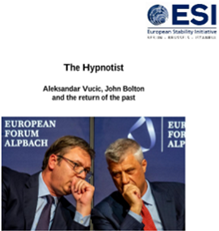
A master of persuasion – and a dangerous agenda
“No doubt unintentionally, the US had appeared to give Milosevic a green light to act [in Kosovo in February 1998]. In terms of the former Yugoslavia this was the second time that an American statement, given in good faith, had been or rather could be interpreted as an invitation to act. In June 1991, James Baker, the US secretary of state, had come to Belgrade and told the leaders … that he did not favour secession [of Slovenia and Croatia]. Four days later conflict began in Slovenia, the Yugoslav army believing that it could act, in part, because of what Baker had said.” (Tim Judah, Kosovo – War and Revenge, 2022)
There is another reason the risk of further escalation in the North this summer has grown: the government in Belgrade may misunderstand signals from the US and the EU, believing that their disagreements with the Kosovo government are now so serious that Serbia might get away with establishing a fait accompli in the North.
The US is calling on Pristina to withdraw the elected mayors from the North to avoid violence, without a plan who would then move into the municipal buildings. When violence erupted in North Kosovo on 26 May 2023, as the newly elected ethnic-Albanian mayors tried to get to their municipal offices and Kosovo special police that accompanied them clashed with Serb protestors, the American ambassador explained that the US had “strongly advised” prime minister Albin Kurti not to do this. When the mayors then remained in their offices, the public learned that Kosovo’s participation in a Nato exercise, Defender Europe 23, was cancelled. Following this, the US ambassador explained that his country was considering other measures and had “no enthusiasm” to assist Kosovo in its efforts to gain wider international recognition or progress towards membership of the EU and Nato. Then, on 14 June, Albanian prime minister Edi Rama cancelled a joint meeting of the Albanian and Kosovo governments, claiming that the meeting could not be held “in the circumstances of Kosovo’s aggravated relations with the entire Euro-Atlantic community.” Rama noted that “we are on the verge of moving a sanctions plan against a state that was created by those who are quietly … running out of patience.”
The EU is also putting pressure on Pristina to withdraw its special police, without a plan how the North would then be policed. On 14 June, European Commission’s spokesperson Peter Stano announced that:
“the 27 EU member states had ‘unanimously’ agreed to take ‘reversible and temporary measures’ against Kosovo, ‘depending on the development on the ground and credible decisive steps by (Kosovo) Prime Minister (Albin) Kurti’.”
The EU had “prepared proposals with measures with immediate effect.” A letter from a senior European Commission official later listed these measures: putting on hold the work of joint (Stabilisation and Association Agreement) bodies; putting on hold the programming of EU funds; not considering proposals submitted by Kosovo under the Western Balkans Investment Framework; putting on hold invitations to high-level events; suspending bilateral visits. Stano explained that “despite our repeated calls, Prime Minister Kurti has so far failed to take decisive steps and actions to de-escalate.”
One secret of Aleksandar Vucic’s remarkably successful political career has been to read balances of power. A good politician, he noted, is not one to run with the head into walls. On 9 September 2018, Aleksandar Vucic explained how this applied to Kosovo in a speech to Kosovo Serbs in North Mitrovica, warning that misery would flow from a lack of realism:
“Milosevic was a great Serbian leader, his intentions were, in any case, for the best, but the results were very bad. Not because he or someone else wanted this, but because his wishes were not realistic ….”
He repeated criticism that the ultranationalist and sentenced war-criminal Vojislav Seselj, whose closest collaborator Vucic had been at that time, made of Milosevic in 1994: that Milosevic had pursued the right cause but had done so without “calculating” Serbia’s actual strength. Vucic noted that Serbs were then “prepared to die for Knin, for Sarajevo, for Pristina.” And yet, he continued, Serbs were displaced from Croatia, Sarajevo and Pristina. Why did this happen?
“All this happened not because Croats, Muslims or Albanians were stronger or more courageous than us, but because we did not understand the position of Serbia in the world. We did not realize that we are not alone in the world and that without the world we cannot succeed. Because we underestimated others and were unable to calculate …”
This summer, however, Serbia no longer appears to be “alone in the world” when it comes to North Kosovo. At this moment, neither the US nor the EU have a plan how to restore calm to the North, other than through a withdrawal by Pristina. There is no vision of what governance in the North should look like after such a withdrawal. There is no vision how to restore the credibility of the dialogue format. There is no vision how to ensure that even technical agreements on matters such as licence plates will ever be implemented. There is no vision how to proceed with the 2023 Ohrid Agreement in the face of open rejection of its core idea by Belgrade. This is a dangerous strategic vacuum. It might yet lead to fatal miscalculations.
After all, the EU has not imposed any similar punitive measures against any other Western Balkan government in recent decades as it now did to pressure Kosovo. At the same time, Vucic might expect pressure on Serbia to implement the Ohrid Agreement to build up before long. Is this summer then his last chance to consolidate control in the North, before a different round of talks replaces the current dysfunctional dialogue?
Of course, KFOR is not withdrawing from Kosovo. In fact, it is sending more soldiers there in the wake of the May violence. But the experience of recent months has shown that the more tensions grew and violence escalated in the North, the louder the calls on the Kosovo government to pull back from the North in the name of de-escalation became. It is a dangerous impression.
Sovereignty – the heart of the matter
The core of the current crisis is obvious: it is the question who exercises sovereignty in North Kosovo. Without a solution to the problem of political authority in North Kosovo, there will be no peace. And without clarity on the reality of the international border between Kosovo and Serbia, there will be no further progress on other issues, either.
After 1999, Serbs in North Kosovo were prepared to use violence repeatedly to reject the authority of UNMIK. In March 2008, following Kosovo’s declaration of independence, United Nations police officers raided a courthouse that had been seized by Serbs in North Mitrovica. In response, hundreds of Serbs attacked international peacekeepers, firing weapons and throwing grenades. The New York Times wrote then that this violence was:
“part of a campaign by Serbs to make Pristina’s administration of northern Kosovo untenable and to force the de facto partition of the territory … Over the past few weeks, Serbian protesters have tried to undermine Pristina’s authority in the north by setting fire to United Nations border posts, disrupting rail lines, attacking European Union and United Nations judicial and administrative offices, and preventing ethnic Albanian judges and lawyers from entering their offices in northern Mitrovica … 22 Poles and 15 Ukrainians belonging to the United Nations police were wounded Monday, along with 9 French members of the NATO force. At least 70 Serbian demonstrators, including one struck in the eye by a bullet, were wounded.” (New York Times, March 2008)
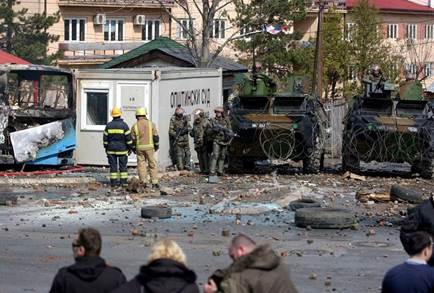
French KFOR troops guarding the gate of the UNMIK court, in Mitrovica, 17 March 2008
April 2013 saw the beginning of a process of tentative integration, linked to an EU-dialogue presented as opening the door to a credible EU-accession process. It worked, because it was backed by Belgrade. Until it no longer was.
Serb leaders in the North have returned to the maximalist demands of the past. They demand to bring to an end any effective authority exercised by Pristina in their region. It is a demand which the government in Pristina will not meet.
Since 2017, Serbia’s current government has pushed for its preferred way out of this dilemma: an ethnic partition of Kosovo. Kosovo’s government rejects this, pushing back to assert authority in North Kosovo to preempt any de facto partition. This leads it to reject demands to withdraw recently elected mayors. It fears a vacuum of authority that will immediately, and irreversibly, be filled by Serbia.
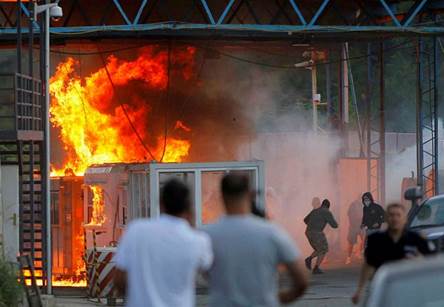
A border crossing between Serbia and Kosovo set ablaze by hundreds of Serb youths, 27 July 2011
In recent weeks, the Serbian Ministry of Foreign Affairs intensified its campaign to alert leaders around the world to Albanian “terror” against Serbs in Kosovo, sharing lists of alleged “terror” crimes. What is worrying is that false claims of massive anti-Serb violence are reminiscent of similar claims made before the imposition of the Serbian apartheid regime in Kosovo in 1989 under Slobodan Milosevic; before the outbreak of war in Croatia and the declaration of a “Serb Republic” backed by Serbia in 1991; and before the outbreak of war in Bosnia and Herzegovina and the declaration of a “Serb Republic” inside that country in 1992. The key message, then and now, is that while others might be minorities in Serbia, Serbs cannot be a minority in any other state, or they risk being killed and terrorized. And that this justifies violence, even war, to defend them.
How this dialogue came to an end
The current EU-led dialogue process is broken. It is incapable of producing trust. It is unable to ensure that technical agreements made more than a decade ago are implemented. It is failing to produce even an implementation plan for a supposedly historic agreement reached earlier this year.
This is a dangerous crisis of European diplomacy, in a situation that is once again a matter of war and peace in the Balkans. But this failure it is not surprising.
When the UN General Assembly adopted its historic resolution in 2010, written by Serbia together with all EU member states, which first called for this EU-led dialogue, its purpose was defined as offering a shared European destination for Kosovo and Serbia:
“the proposed dialogue between the parties would help promote cooperation, achieve progress on the path to the European Union and improve the lives of the people.”
This is also how it worked at first. In November 2011, the European Commission recommended granting Serbia candidate status “on the understanding that Serbia reengages in the dialogue with Kosovo and is moving swiftly to the implementation in good faith of agreements reached to date.”
In March 2012, Serbia was granted candidate status when EU member states were convinced that it “has achieved further progress in moving forward with the implementation in good faith of agreements reached in the dialogue.”
On 22 April 2013, the European Commission recommended opening of accession talks with Serbia, three days after it signed the “First Agreement of Principles Governing the Normalization of Relations” in Brussels.
In June 2013, EU member states agreed to open accession talks with Serbia by next January, after Belgrade and Pristina agreed in May on the Implementation Plan of the Brussels agreement.
In December 2013, EU member states agreed on their position on accession talks with Serbia, referring directly to the dialogue and the common European destination for Serbia and Kosovo:
“This process shall ensure that both can continue on their respective European paths, while avoiding that either can block the other in these efforts and should gradually lead to the comprehensive normalization of relations between Serbia and Kosovo, in the form of a legally binding agreement by the end of Serbia’s accession negotiations.”
Aleksandar Vucic was Serbian prime minister when his government acknowledged that “the EU accession process and normalisation process should run parallel and support one another” and that “Serbia will remain entirely committed to the continuation of the normalisation process and its dialogue with Pristina.”
In 2013 Serbia’s neighbour Croatia became an EU member. At the time, the EU accession process was credible. It no longer is. And so, at the very moment when the EU is trying to push for a breakthrough and the hardest concessions, neither Serbia nor Kosovo have a credible EU perspective. And with this, the heart has been ripped out of the body of the dialogue, leaving a Zombie.

On the crisis of EU accession in the Balkans
ESI background: Scoreboard – The true state of accession – What the Commission assessments reveal (17 March 2023)
ESI report: The Balkan Turtle Race – A warning for Ukraine (13 July 2022)
ESI newsletter: Europe, Ukraine and a second Treaty of Rome, 16 June 2022
DGAP (Gerald Knaus): Action Plan for the Western Balkans and EU Neighborhood, September 2021
ESI report: Hamster in the Wheel. Credibility and EU Balkan policy, 15 January 2020
In reality, the most important dialogue to bring about progress in Kosovo has never been the one between Belgrade and Pristina, and this is unlikely to change soon. It has been two other dialogues that really mattered: the one between Brussels and Belgrade and the other between Brussels and Pristina.
It is these dialogues that need to be revived now, urgently. It is to this, that leaders in Brussels, Pristina, Belgrade, but also in Berlin and Paris, need to turn before it is too late. They need to have an answer also to a very concrete question: how does a promise of European integration matter to the people in North Mitrovica and Leposavic, at a time when Serbia is stuck, and Kosovo not even able to apply for accession?
Alas, violence is an option. As the poet Seamus Heaney, who grew up near Derry and saw Northern Ireland descend into hell in 1969, once wrote: “history says, don’t hope.” Certainly, hope will not be enough for the EU. It must quickly change its deeply flawed process of mediation. It must explain: What is the European vision for Mitrovica? And it must acknowledge, first to itself, that a dialogue based on the promise of EU integration cannot work without this promise being credible.
Yours sincerely,

Gerald Knaus

ESI Balkan team in Sarajevo, May 2023
ESI on Mitrovica
ESI published three papers on Mitrovica and Kosovo Serbs in 2004, another year of violence in Kosovo:
A post-industrial future? Economy and society in Mitrovica and Zvecan
People Or Territory? A Proposal for Mitrovica
The Lausanne Principle: Multiethnicity, Territory and the Future of Kosovo’s Serbs


2004: Mitrovica’s economy and society – What future for Kosovo Serbs?
In 2004, there were an estimated 129,000 Serbs still living in Kosovo, out of a pre-war population of 194,000. One third of Serb pupils in Kosovo went to school in the three municipalities in the North – Zvecan, Zubin Potok, Leposavic – and in North Mitrovica. The majority of Kosovo Serbs, however, lived among Albanians in the South.
The European Stability Initiative is being supported by Stiftung Mercator
